By: J.V. Askem
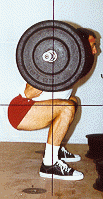
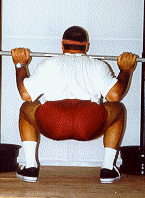
1 & 2: A regular athletic back sided squat.


When doing a back sided athletic squat
1. Assume a shoulder width stance.
2. Keep both feet flat on the floor. (Flat shoes with a hard sole
are recommended).
3. Pull your shoulder blades together and stick your chest out.
4. Look down slightly at a spot on the wall about belt height. This
will then have you looking straight ahead when in the bottom position.
5. Keep the bar's center of gravity over your feet (note the vertical
line).
6. Stop descending as soon as your back starts to round forward
(see next photo 3).
The above two photos, plus the photos that follow below, are designed to help the average trainee ascertain whether they are performing their squats properly for athletic weight training. You will notice that there are two lines on all the profile photos, one horizontal and one vertical. The horizontal line shows the relation of hip joint to the knee joint, which is what determines adequate depth. And the vertical line shows the center of gravity of the bar in relation to the feet, which determines proper balance.
A trainee's goal should always be to squat as low as possible. If a rock bottom position can not be reached, at least a below parallel position should be the trainee's goal. A "parallel squat" is where the hip joint is in line with the knee joint. Always try to get lower than parallel while still maintaining a straight spine with the center of gravity of the barbell over the feet. For ideal balance, the center of gravity of the barbell should be over the feet, between the balls of the feet and the front part of the heels of the feet.
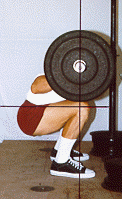
3: Because of long legs combined with
a short truck, the back rounds forward
when descending too deep.
This is a dangerous position and could
result in a lower spine injury. Always try
to hold a straight back as shown in photo 1.
Note 1: The amount of forward lean depends on each individual's body
leverage. Long legs with a short trunk will cause a person the lean forward
more. If you have the fore mentioned leverage, and you want to squat deeper,
Front Squats are recommended.
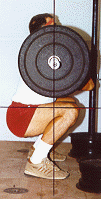
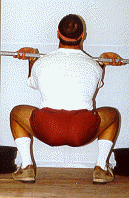
4 & 5: A regular "hands on" front squat.
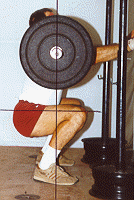
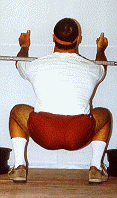
6 & 7: A "no hands" front squat
Note 2: When front squatting, wearing shoes with heels will allow
a more upright stance, but holding the proper position requires more flexibility
in the knees, hips, and lower spine.
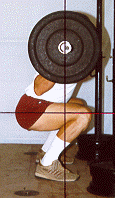
8: A back squat with heeled shoes.
Also known as an Olympic Style Squat.
Note less forward lean in the upper body than
the previous heeless shoe back squat, but there
is still more forward lean than the Front Squats.
Also because of poor leverage, notice the depth is compromised.
To get lower the subject here would have to round the back.
Front Squats are still recommended with
this body leverage.
Overhead Squats

9: Note the upper body is more
upright than a back squat.
Also, note the center of gravity line
intersects over the feet. This particular
body leverage requires extra shoulder flexibility
to maintain this proper positioning.
Leverage of a longer trunk with shorter
legs will allow
a trainee to sit more upright with the
bar more directly
overhead, rather than slightly behind the
head as shown.
The Good Morning

10: Note the center line intersecting
with the feet. This is a must.
Also note: the shins are vertical, the
hips are back as far as they can go, and
most important, the
back (spine) is straight.
GM's done in the above fashion will
strengthen the necessary muscles to hold
proper squat positioning. In this case this is
known as stabilizing strength rather than prime
mover strength. .
How NOT To Squat!!!
The following six photos show two trainees who I have worked with.
Both examples show flaws in their squat form. The first suggestion I made
to both young men was not wear their the spongy basketball/ jogging shoes,
but rather squat in their stocking feet, until they got some adequate footwear
to maintain a solid footing for squatting.



Subject One: shows an OK stance from the back, but you
can see
the barbell is too far forward in the profile. This in turn compromises
his depth. Thus he's too high.
Also on the right, notice that he's pulling his knees inward as
he rises.
This is a NO NO! Always track your knee joints like door hinges,
keeping
your knees pulled out and in line with your feet.



Subject Two: shows an OK stance, but the hands could be
in closer.
However, in the profile, notice the excessive forward lean. This
is
caused by too much tightness in the lower spine, and compromises
his depth.
To counter this weakness I suggested Good Mornings be done once
or twice
a week. NOTE: If you're also doing deadlifts in your training,
it's recommended
that GM's be done just once per week.
On the right, just 3 weeks later, notice the improvement. You
can now see
better depth, plus the center of gravity of the barbell is back
over the feet
where it should be. This is not a perfect squat, but it shows
that the trainee
is headed in the right direction.
Good luck to your all with your training. JVA